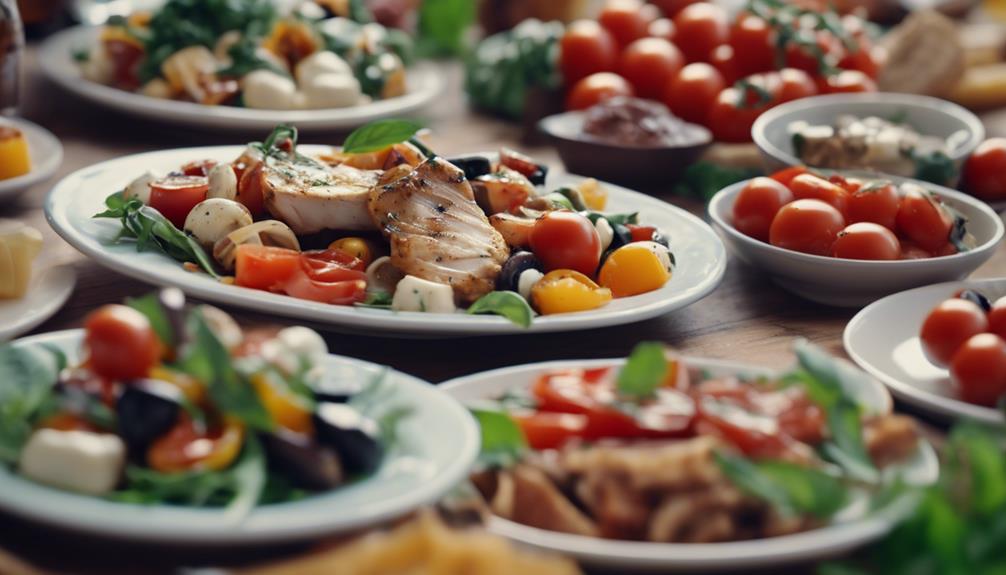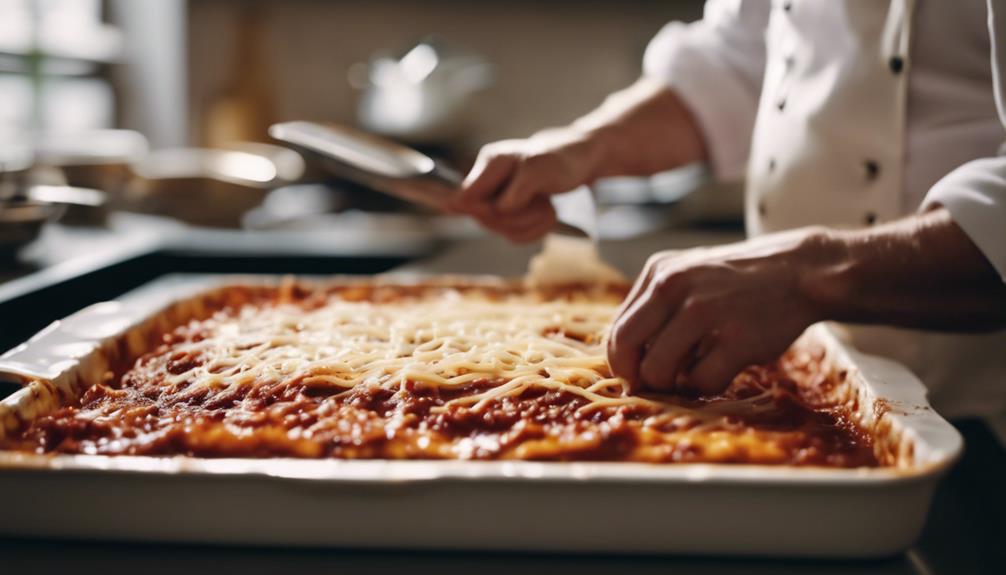If you’re looking for Italian dishes with reduced sodium levels, check out these tasty options that won’t leave you feeling bloated with salt: Bruschetta, a zesty mix of fresh tomatoes, garlic, and basil; Caprese Salad, a burst of flavors from tomatoes, mozzarella, and balsamic vinegar; Grilled Vegetables seasoned with herbs like rosemary and thyme; Seafood Pasta packed with omega-3s featuring shrimp and scallops. Looking for more ideas? Try Chicken Piccata, Eggplant Parmesan, and Tuscan Bean Salad – each with their own delicious twist to satisfy your cravings. Surprise your taste buds with these low-sodium Italian delights!
Key Takeaways
- Bruschetta with fresh tomatoes, garlic, and olive oil is a low-sodium Italian appetizer.
- Caprese Salad is a vibrant, low-sodium option with fresh tomatoes, mozzarella, and basil.
- Grilled Vegetables seasoned with herbs and olive oil offer a flavorful, low-sodium choice.
- Season seafood pasta with shrimp and scallops for a low-sodium, nutrient-rich Italian dish.
- Enjoy Chicken Piccata with lemon and capers for a low-sodium, zesty Italian meal.
Bruschetta
When making bruschetta, opt for fresh tomatoes, garlic, basil, and olive oil to enjoy a low-sodium Italian appetizer. This classic dish isn't only delicious but also one of the best low-sodium options in Italian cuisine. By using these fresh ingredients, you can savor the flavors without worrying about excessive sodium intake.
The tomatoes provide a juicy and tangy base, while the garlic adds a robust kick to the mix. Fresh basil brings a lovely herbaceous note, and the olive oil ties everything together with its rich and smooth texture.
Bruschetta is a fantastic choice for those looking to reduce their sodium intake without sacrificing taste. The simplicity of this dish allows the natural flavors to shine through, making it an invigorating and heart-healthy appetizer.
Caprese Salad
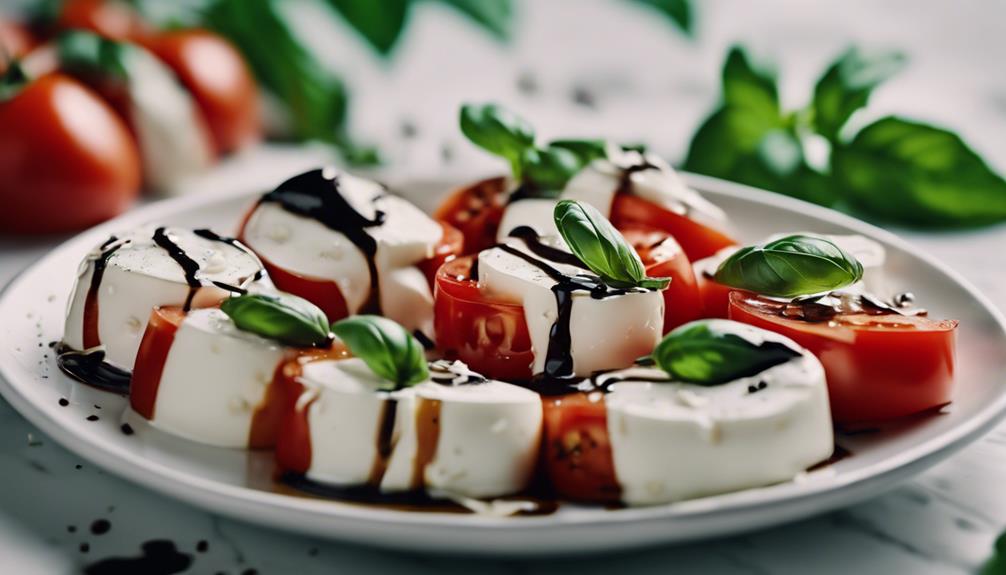
For another low-sodium option in Italian cuisine, consider trying a flavorful Caprese Salad made with fresh tomatoes, mozzarella cheese, basil, olive oil, and balsamic vinegar. This classic dish embodies the essence of Italian food with its simplicity and vibrant colors.
The beauty of a Caprese Salad lies in the quality of its ingredients, which naturally offer a burst of flavor without the need for added salt. It's a light and invigorating choice, perfect as an appetizer or side dish, that can cater to your taste buds while keeping your sodium intake in check.
When it comes to sodium in Italian recipes, Caprese Salad stands out as a delicious and healthy alternative. Unlike dishes that may rely heavily on salt for taste, this salad lets the fresh produce and quality cheese shine.
Grilled Vegetables
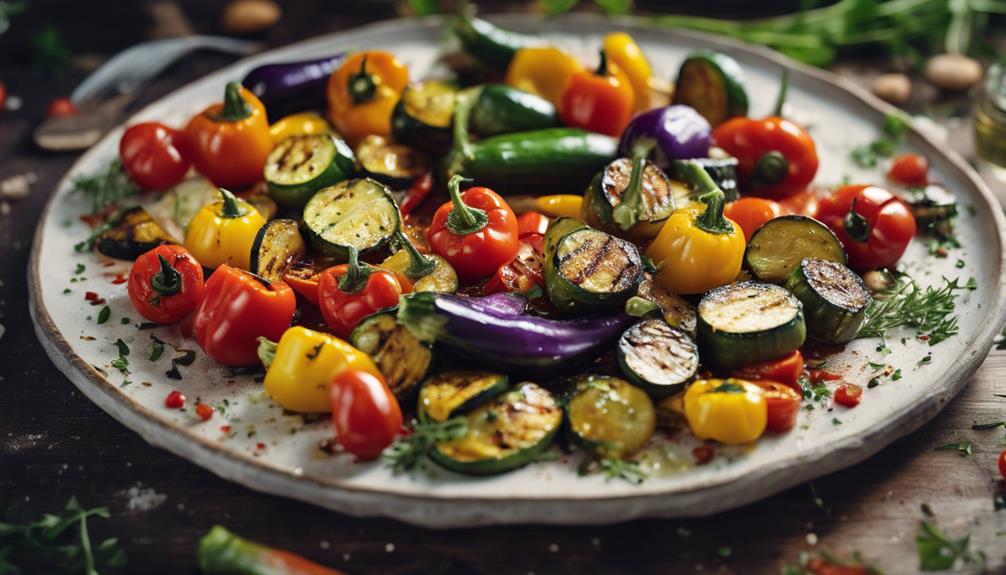
Grilled vegetables pack a flavorful punch without the need for excess salt.
Enhance the taste of zucchini, bell peppers, and eggplant with herbs, garlic, and a drizzle of olive oil.
Your taste buds and health will thank you for choosing this low-sodium option!
Seasoning for Flavor
Enhance the flavor of your grilled vegetables by seasoning them with herbs like rosemary, thyme, and oregano for a salt-free alternative. These aromatic herbs can work wonders in transforming your veggies into a savory delight without the need for sodium.
If you're looking to add a zesty kick, consider using a marinade of olive oil, garlic, and a splash of lemon juice. The acidity of the lemon juice not only brightens up the dish but also enhances the natural flavors of the grilled vegetables.
Grilling vegetables not only imparts a smoky essence but also caramelizes their natural sugars, elevating their taste profile without relying on salt. For a twist, try experimenting with different spice blends like Italian seasoning or a drizzle of balsamic glaze to take your grilled veggies to the next level.
These flavorful additions can turn your low-sodium side dish or main course into a culinary masterpiece that's both delicious and healthy. So, fire up the grill and get ready to savor every bite of your herb-infused, lemon-kissed grilled vegetables!
Health Benefits
Transforming your grilled vegetables into a low-sodium, nutrient-rich dish not only enhances their natural flavors but also offers numerous health benefits.
Grilled vegetables are a powerhouse of essential nutrients, vitamins, and minerals that support your overall well-being. By grilling them, you can intensify their flavors without the need for added salt, making them a delicious and healthy addition to your meals.
Including a variety of grilled vegetables in your diet can help lower the risk of high blood pressure and promote heart health. Opting for grilled vegetables in Italian dishes provides a flavorful and low-sodium option that your taste buds and your body will thank you for.
Seafood Pasta
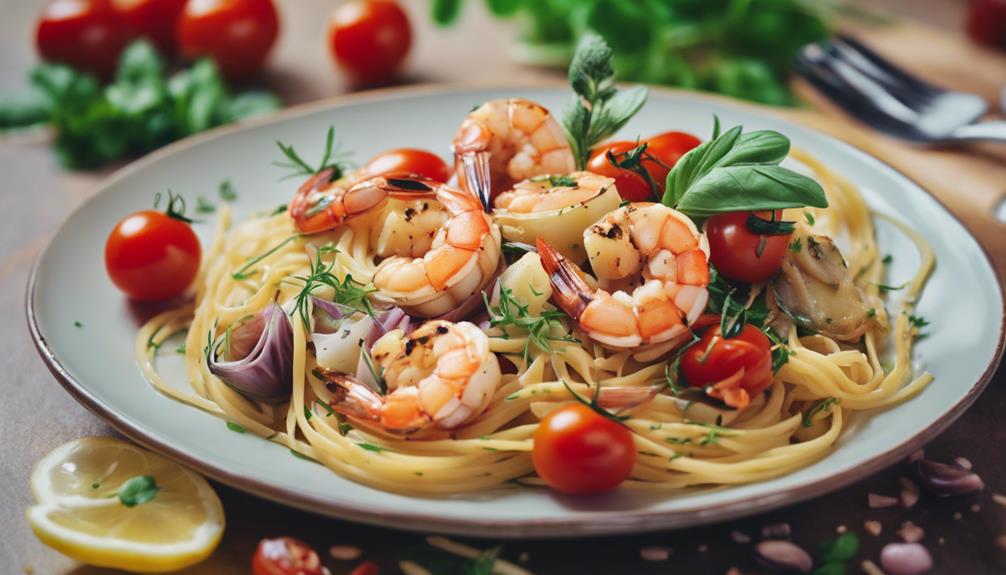
When it comes to seafood pasta, you're in for a treat! These dishes not only offer a delicious taste but are also low in sodium, making them a great choice for your health.
Get ready to explore the health benefits of seafood and pick up some handy tips for reducing sodium intake in your Italian cuisine.
Health Benefits of Seafood
Seafood pasta, with its incorporation of shrimp and scallops, offers a flavorful and satisfying option for low-sodium Italian dishes while providing essential nutrients like protein and omega-3 fatty acids. Here are some health benefits of seafood:
- Heart Health: Seafood is naturally low in sodium and can help support a healthy heart. The omega-3 fatty acids found in seafood have been linked to reducing the risk of heart disease.
- Protein Powerhouse: Seafood is a great source of high-quality protein, which is essential for building and repairing tissues in your body. Shrimp and scallops in seafood pasta can help you meet your protein needs.
- Brain Boost: Omega-3 fatty acids, abundant in seafood, are known for their brain-boosting benefits. Including seafood in your diet, like in a delicious seafood pasta dish, can help support cognitive function and memory retention.
Sodium Reduction Tips
To reduce sodium content in your seafood pasta dishes, consider opting for fresh seafood choices and incorporating flavorful herbs and spices. Fresh seafood not only adds a delicious taste to your Italian creations but also helps keep your sodium intake in check.
Instead of reaching for the salt shaker, experiment with herbs like basil, oregano, and thyme, along with zesty spices such as paprika and red pepper flakes. Adding a splash of lemon juice can also elevate the flavors without the need for extra salt.
When preparing your seafood pasta, choose whole wheat pasta for an extra dose of fiber and nutrients. This healthy swap not only enhances the dish's nutritional value but also contributes to a satisfying meal.
Additionally, explore low sodium sauces and seasonings to infuse your seafood pasta with delectable taste without compromising on your sodium reduction efforts. With these simple yet effective tips, you can enjoy flavorful and low sodium seafood pasta dishes that are both delicious and nutritious.
Minestrone Soup
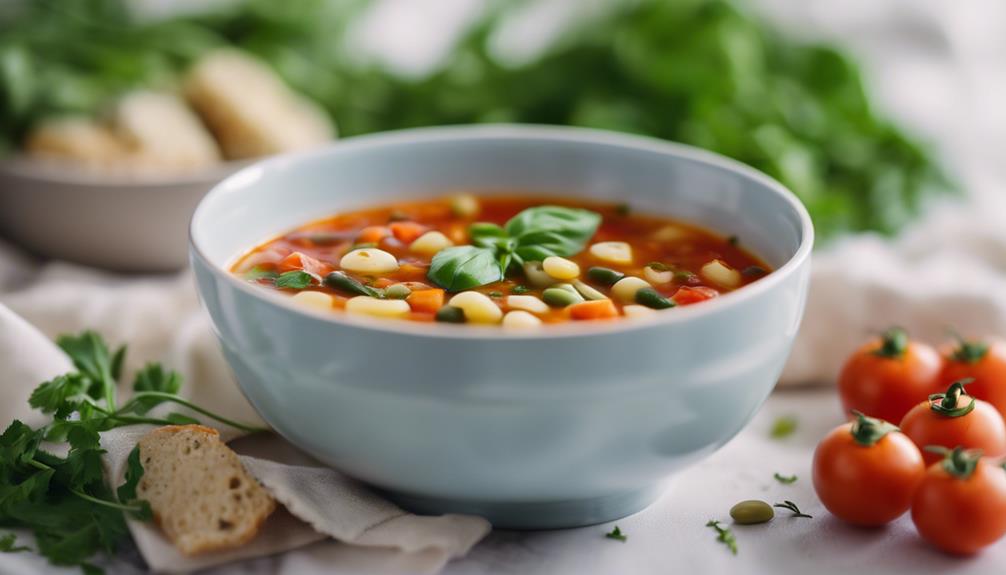
Minestrone soup, with its naturally low sodium content and nutrient-rich vegetable base, is a flavorful and healthy option for your Italian dining experience. Here are some reasons why it's a great choice:
- Nutrient-Packed: This hearty soup is a treasure trove of nutrients from various vegetables like tomatoes, carrots, celery, and beans. It not only tantalizes your taste buds but also provides a healthy dose of essential vitamins and minerals.
- Low-Sodium Seasoning: By opting for fresh herbs and spices to season your minestrone soup instead of salt, you can elevate its taste without increasing the sodium levels. It's a simple yet effective way to keep your meal heart-friendly.
- Customizable Delight: The beauty of minestrone soup lies in its versatility. You can personalize it with a variety of vegetables and herbs to cater to your unique flavor preferences and dietary requirements. Embrace the freedom to create a bowl that suits your taste perfectly.
Chicken Piccata
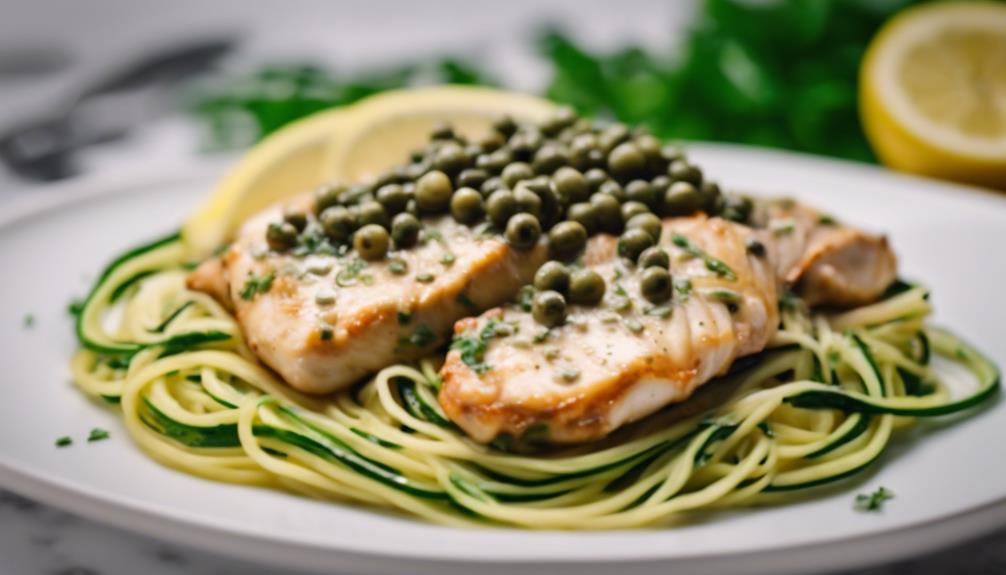
When preparing Chicken Piccata, you can enjoy a delicious low-sodium Italian dish featuring tender chicken, zesty lemon, briny capers, and a splash of white wine. This flavorful combination creates a light and tangy dish that's perfect for those looking to keep their sodium intake in check. With approximately 200-300mg of sodium per serving, Chicken Piccata proves to be a heart-healthy option that doesn't compromise on taste.
One of the best things about Chicken Piccata is its versatility. You can easily customize it by adding your favorite herbs and spices to enhance the flavors further. The dish isn't only easy to prepare but also pairs exceptionally well with a variety of side dishes like steamed vegetables or a side of whole grain pasta, making it a well-rounded and satisfying meal.
Eggplant Parmesan
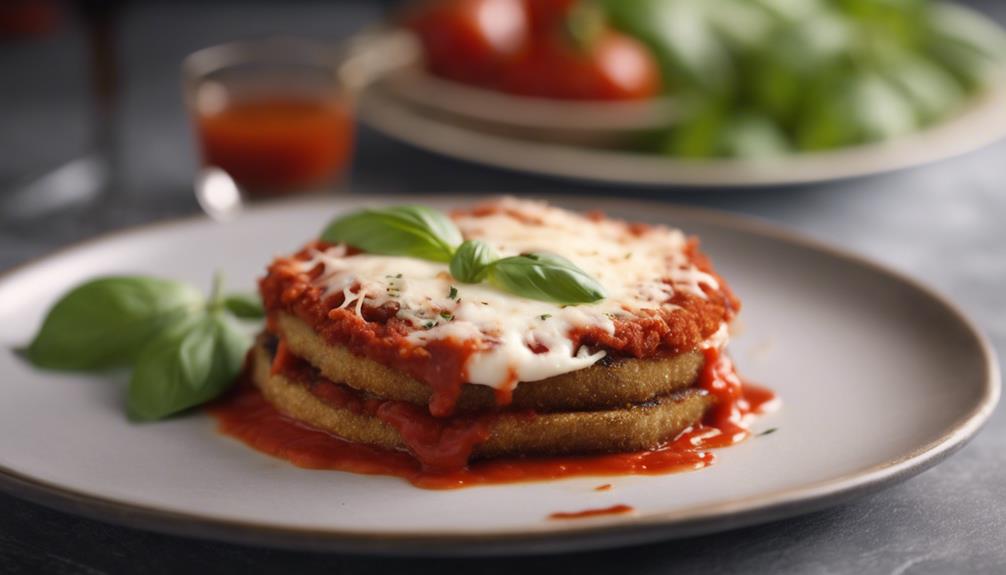
Eggplant Parmesan, a classic Italian dish known for its layers of flavors, offers a delicious and naturally low-sodium option for a satisfying meal. Here are some facts about this flavorful dish:
- Low Sodium Content: Eggplant Parmesan contains approximately 172 mg of sodium per serving, making it a heart-healthy choice for those watching their sodium intake.
- Layered Goodness: This dish features succulent layers of eggplant, tangy marinara sauce, and gooey cheese, creating a symphony of flavors that will leave your taste buds dancing with delight.
- Italian Authenticity: By incorporating fresh herbs, garlic, and olive oil, Eggplant Parmesan stays true to its Italian roots while keeping the sodium levels in check. This dish proves that you can enjoy the rich flavors of Italy without worrying about excess sodium intake.
Savor the comforting and flavorful experience of Eggplant Parmesan, a low-sodium Italian favorite that brings a taste of Italy to your table without the guilt.
Tuscan Bean Salad
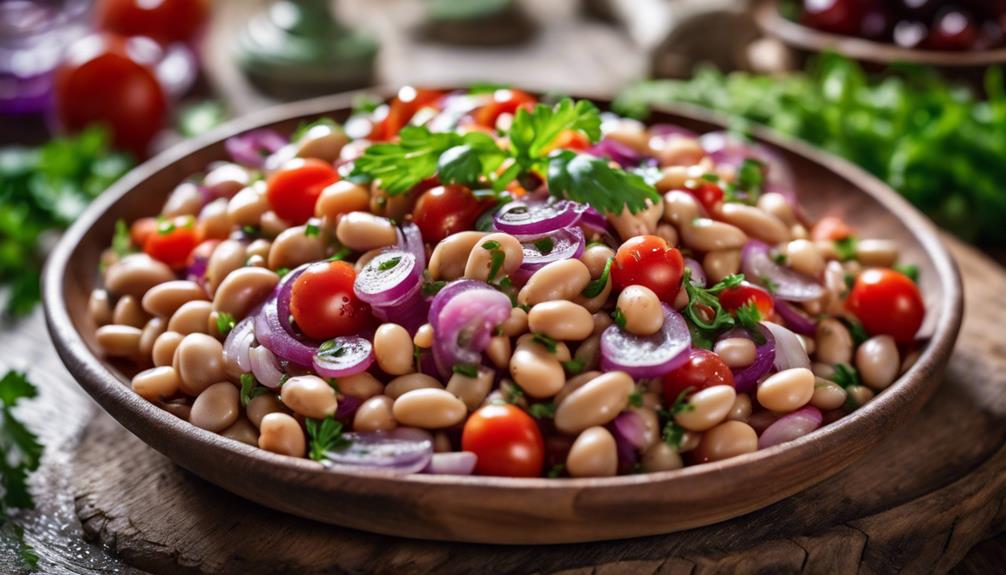
Indulge in the nutritious and flavorful Tuscan Bean Salad, a low-sodium Italian dish packed with fiber and protein. This salad not only satisfies your taste buds but also nourishes your body with the goodness of cannellini beans, rich in antioxidants, vitamins, and minerals essential for your overall health.
The blend of ingredients like juicy tomatoes, fragrant basil, and drizzles of olive oil creates a symphony of flavors without the need for added salt, making it a wholesome choice for those watching their sodium intake.
Imagine savoring the simplicity and freshness of Tuscan Bean Salad, either as a standalone meal or a delightful side dish. By incorporating this dish into your low sodium diet, you aren't just treating your palate but also promoting heart health and supporting the well-being of your kidneys.
Lemon Garlic Shrimp
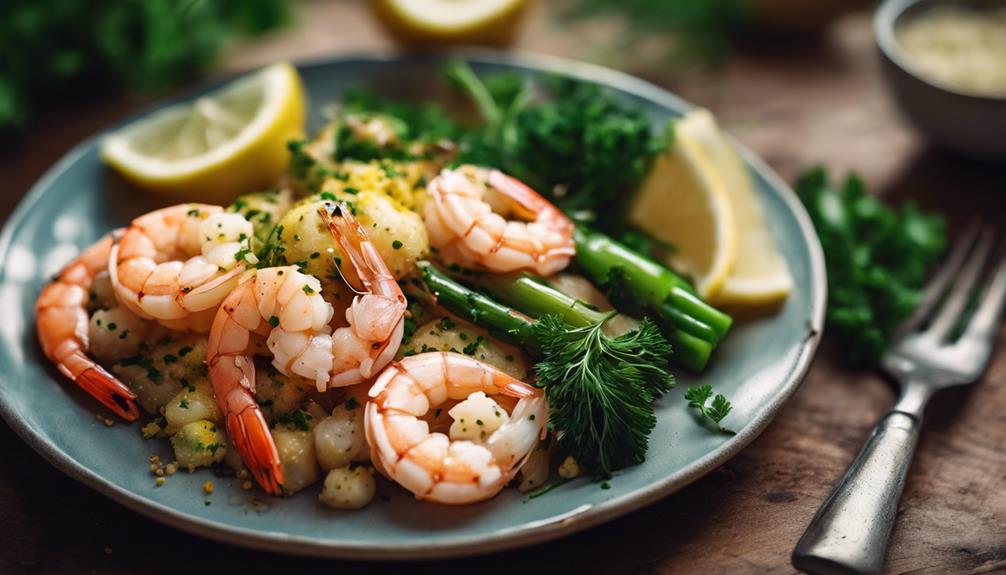
Satisfy your taste buds with the light and flavorful Lemon Garlic Shrimp, a delicious low-sodium Italian dish that combines shrimp, lemon juice, garlic, and herbs.
Here's why you should give this dish a try:
- Nutrient-Rich: Lemon Garlic Shrimp isn't just tasty; it's also packed with protein, vitamins, and minerals, making it a healthy choice for those conscious of their sodium intake.
- Refreshing Flavors: The zesty lemon juice in this dish adds a tangy kick that perfectly complements the savory garlic and herb notes, creating a symphony of flavors without the need for added salt.
- Quick and Easy: With its simple preparation and short cooking time, Lemon Garlic Shrimp is a convenient option for a satisfying low-sodium Italian meal that won't keep you tied up in the kitchen all evening.
Frequently Asked Questions
What Italian Food Is Low in Salt?
When you're looking for Italian food that's low in salt, there are delicious options like Eggplant Parm with Roasted Red Pepper Sauce, Stuffed Shells with Spinach and Parsley, Linguine with Garlic and Tuna, and more.
What Pasta Is Low in Sodium?
Looking for low-sodium pasta? Explore healthy options like Fettuccine with Parsley Pesto for a mere 20.2 mg per serving. Why settle for salty when you can savor Spaghetti Squash with Tomatoes and Zucchini at 198 mg?
What Is the Healthiest Italian Dish?
For the healthiest Italian dish, try Tuscan White Bean Soup. It's hearty, flavorful, and low in sodium. Packed with fiber and goodness, it's a satisfying option that nourishes your body and delights your taste buds.
Is Food in Italy High in Sodium?
Italian cuisine tends to be lower in sodium compared to Americanized versions. With a focus on fresh ingredients and herbs, you can enjoy flavorful dishes without excessive salt. Olive oil and red sauces add richness naturally.
Can the Best Italian Dishes Also Be Low in Sodium?
Looking for the best Italian dishes for you that are also low in sodium? It’s possible to enjoy flavorful Italian cuisine without a high-salt content. Try options like caprese salad, grilled fish with herbs, or vegetable risotto. With the right recipes and fresh ingredients, you can savor delicious, low-sodium Italian dishes.
Conclusion
So there you have it, a delicious list of Italian dishes low in sodium to satisfy your taste buds without the guilt.
Who knew eating healthy could taste this good?
So go ahead, indulge in these flavorful options and enjoy a meal that's both tasty and heart-friendly.
Buon appetito!
